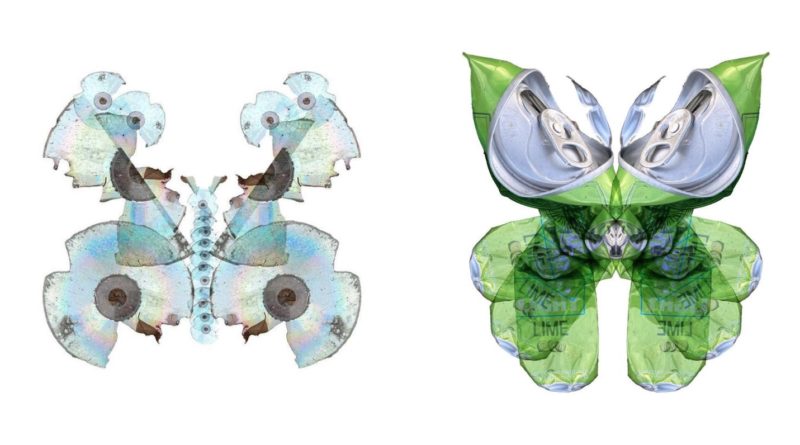UD senior makes art from campus litter
Two of Mia Gaskey’s butterflies created from a beer can and a CD. Photo courtesy of Gaskey.
Kasey Conway | Contributing Writer
As students walk the streets of the student neighborhood, a young woman stops to bend down and take pictures of plastic masks and smashed beer bottles that lay on the sidewalk. She continues walking and stumbles across a pile of cigarette filters.
“Four cigarette filters take 18 months to 10 years or more to decompose,” she said. “They are the most littered item in the U.S. and the world.”
She bends down, snaps a few pictures of the littered cigarettes and continues her way toward her home.
Mia Gaskey, 22, a senior at the University of Dayton designs and creates artwork from litter she finds in Dayton. As a graphic design major, the art student has worked with a tight-knit group of students who feed off each other’s inspirations and creativity. Gaskey and her classmates display their artwork in Orpheus, UD’s art and literacy magazine, which she has pushed be offered to students in every building on campus.
“Not a lot of students even know what Orpheus is,” Gaskey said while she pointed to one of her classmate’s work. “Most of the work in this magazine is made by my classmates. We submit all our work to it [Orpheus] at the end of each semester.”
Her most popular and recent design “Decomposing Butterflies” earned her $600 a piece. It was featured in the most recent addition of Orpheus (volume 119). During her process of creating this piece, she roamed the streets of the student neighborhood and UD campus, took pictures of different littered items — such as plastic cutlery or CDs — and digitally constructed butterflies on her laptop using the pictures of litter. The poster includes eight butterflies and each butterfly was created using a different material she found littered.
Statistics of the different waste used for each butterfly are provided on her portfolio and Instagram page, where she explains how each of these materials are detrimental to the environment and approximately how long each item takes to decompose.
For example, Gaskey used pictures of a littered Heineken bottle to create one of her butterflies. This butterfly is posted on her Instagram, @mindofmeesh, where she posts most of her artwork.
“A modern glass bottle would take 4000 years or more to decompose,” she captioned it.
The senior created the butterfly poster for her graphic design class, taught by Misty Thomas-Trout, who helped her in perfecting the project. Her butterfly creations, which are crafted, framed and sold to local clients, have opened a gate for the Gaskey and have introduced her to a variety customers and clients. The butterflies are one of her most expensive pieces, and she does not plan on discounting them any time soon.
“I think it’s really important for artists to value their work, and I’m proud to be selling my butterflies for $600 each,” Gaskey said.
She decided to show her butterfly posters to her former Earth, Environment and Society professor, Lisa Oakley. The artist told Oakley the lessons she learned from that sustainability class encouraged her to uniquely represent the harmful effects of pollution. Shortly after Gaskey showed her designs, her former professor emailed her with an incentive.
“My professor said the Science Center was going to be remodeled and would be interested in displaying my designs in the remodeled building,” Gaskey said.
Gaskey expressed that she would be thrilled to have her art displayed in the Science Center. Her environmental sustainability courses, specifically her course with Oakley, have taught her the effects of a variety of environmental issues, which she plans to continue to feature in her artwork.
While pollution has been the center of Gaskey’s most recent artwork, her love for nature has been a reoccurring theme in her art for as long as she can remember.
When asked who her biggest inspiration for her art was, Gaskey said, “Mother Nature,” with a soft smile.
The young creator expressed that although she lets her creativity flow to places she doesn’t always intend it to, she is still a perfectionist and her art professors encourage that. If there is one wrong glare, smudge or texture, her professors will tell her to resubmit the assignment until it is perfect. She finds their strict critiques beneficial and values the need for her artwork to be perfect and wants her buyers to know this. She expresses the importance of seeing her art it for what it’s worth, which is how she has made an incredible profit.
“I am very confident in my creativity,” Gaskey said.
For more arts and entertainment news, like Flyer News on Facebook and follow us on Twitter (@FlyerNews & @FlyerNewsSports) and Instagram (@flyernews)

